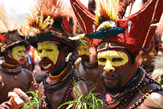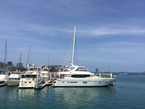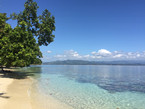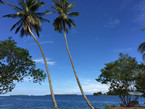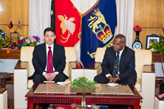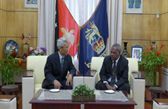Government
2003-11-24 00:00

Country name:
conventional long form: Independent State of Papua New Guinea
conventional short form: Papua New Guinea
abbreviation: PNG
Data code: PP
Government type: parliamentary democracy
Capital: Port Moresby
Administrative divisions: 20 provinces; Bougainville, Central, Chimbu, Eastern Highlands, East New Britain, East Sepik, Enga, Gulf, Madang, Manus, Milne Bay, Morobe, National Capital, New Ireland, Northern, Southern Highlands, Western, Western Highlands, West New Britain, West Sepik
Independence: 16 September 1975 (from the Australian-administered UN trusteeship)
National holiday: Independence Day, 16 September (1975)
Constitution: 16 September 1975
Legal system: based on English common law
Suffrage: 18 years of age; universal
Executive branch:
chief of state: Queen ELIZABETH II (since 6 February 1952), represented by Governor General Silas ATOPARE (since 13 November 1997)
head of government: Prime Minister Michael SOMARE (since August 2002); Deputy Prime Minister Allan Marat
cabinet: National Executive Council appointed by the governor general on the recommendation of the prime minister
elections: none; the monarch is hereditary; governor general appointed by the National Executive Council; prime minister and deputy prime minister appointed by the governor general for up to five years on the basis of majority support in National Parliament
Legislative branch: unicameral National Parliament - sometimes referred to as the House of Assembly (109 seats, 89 elected from open electorates and 20 from provincial electorates; members elected by popular vote to serve five-year terms)
elections: last held April to July 2002
Judicial branch: Supreme Court, the chief justice is appointed by the governor general on the proposal of the National Executive Council after consultation with the minister responsible for justice, other judges are appointed by the Judicial and Legal Services Commission
International organization participation: ACP, APEC, AsDB, ASEAN (observer), C, CP, ESCAP, FAO, G-77, IBRD, ICAO, ICFTU, ICRM, IDA, IFAD, IFC, IFRCS, IHO, ILO, IMF, IMO, Intelsat, Interpol, IOC, IOM (observer), ISO (correspondent), ITU, NAM, OPCW, Sparteca, SPC, SPF, UN, UNCTAD, UNESCO, UNIDO, UPU, WFTU, WHO, WIPO, WMO, WTrO
Flag description: divided diagonally from upper hoist-side corner; the upper triangle is red with a soaring yellow bird of paradise centered; the lower triangle is black with five white five-pointed stars of the Southern Cross constellation centeredc
